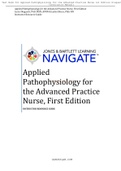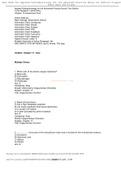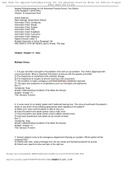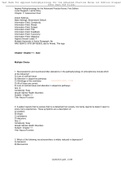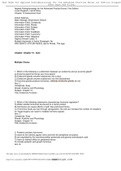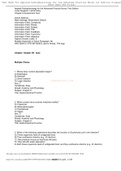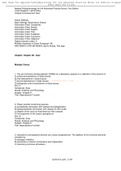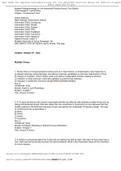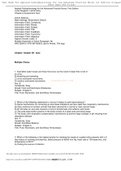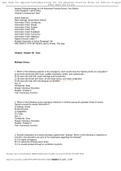St. Thomas University ( )
Latest uploads at St. Thomas University ( ). Looking for notes at St. Thomas University ( )? We have lots of notes, study guides and study notes available for your school.
-
134
- 0
-
3
Majors at St. Thomas University ( )
Notes available for the following studies at St. Thomas University ( )
Latest notes & summaries St. Thomas University ( )
Applied Pathophysiology for the Advanced Practice Nurse Contents Applied Pathophysiology for the Advanced Practice Nurse .......................... Error! Bookmark not defined. Jones & Bartlett Learning............................................................................................................................ 3 For Instructors Who Are Teaching Completely Online Courses ............................................................... 3 Enhancing the Online Learning Experience ...
1. Which cells of the dermis release histamine? A) Mast cells B) Eosinophils C) Macrophages D) Histiocytes Ans: A Complexity: Easy Ahead: Inflammatory Integumentary Disorders Subject: Chapter 13 Title: Integumentary Function 2. Basal cell carcinoma: A) has a high metastasis potential. B) can cause significant local tissue destruction. C) is usually not nodular. D) is often preceded by actinic keratosis. Ans: B Complexity: Easy Ahead: Integumentary Disorders Subject: Chapter 13 ...
Chapter: Chapter 14 - Quiz Multiple Choice 1. A 6-year-old child is brought to the pediatric clinic with an eye problem. The child is diagnosed with viral conjunctivitis. What is important information to discuss with the parents and child? A) The importance of compliance with antibiotic therapy B) The importance of surgery to prevent scarring of the conjunctiva C) The condition is highly contagious and hand washing is extremely important D) The signs and symptoms of complications such as ...
1. Neuroanatomic and neurotransmitter alterations in the pathophysiology of schizophrenia include which of the following? A) Loss of cortical tissue B) Alteration in dopamine pathways C) Shrinkage of the ventricles D) All of these are correct. E) Loss of cortical tissue and alteration in dopamine pathways Ans: E Complexity: Easy Ahead: Mental Health Disorders Subject: Chapter 11 Title: Neural Function 2. A patient reports that he senses that he is detached from society. His family re...
1. Which of the following is a distinction between an endocrine and an exocrine gland? A) Exocrine gland hormones are more potent. B) Endocrine glands secrete substances into a duct. C) Endocrine glands secrete substances into the bloodstream. D) Exocrine glands produce hormones, whereas endocrine glands do not. Ans: C Complexity: Easy Ahead: Anatomy and Physiology Subject: Chapter 10 Title: Endocrine Function 2. Which of the following statements characterizes hormone regulation? A) W...
Chapter: Chapter 09 - Quiz Multiple Choice 1. Where does nutrient absorption begin? A) Esophagus B) Stomach C) Small intestine D) Large intestine Ans: C Complexity: Easy Ahead: Anatomy and Physiology Subject: Chapter 9 Title: Gastrointestinal Function 2. Which cranial nerve controls intestinal motility? A) Trigeminal B) Glossopharyngeal C) Hypoglossal D) Vagus Ans: D Complexity: Easy Ahead: Anatomy and Physiology Subject: Chapter 9 Title: Gastrointestinal Function 3. Which ...
1. The sex hormone–binding globulin (SHBG) on a laboratory analysis is a reflection of the amount of: A) unbound testosterone in body tissues. B) free testosterone in body tissues. C) bound testosterone in body tissues. D) biologically active testosterone in body tissues. Ans: C Complexity: Easy Ahead: Anatomy and Physiology Subject: Chapter 8 Title: Reproductive Function 2. Proper erectile functioning requires: A) sympathetic stimulation with release of prostaglandins. B) parasymp...
1. During times of increasing blood volume such as in heart failure, a compensatory renal response is: A) afferent arteriole vasoconstriction and efferent arteriole vasodilation to promote reabsorption of fluid. B) release of urodilatin, which inhibits water and sodium reabsorption thereby leading to diuresis. C) inhibition of atrial and brain natriuretic peptides to prevent fluid retention. D) increase in antidiuretic hormone release which promotes diuresis. Ans: B Complexity: Easy Ahead...
Chapter: Chapter 06 - Quiz Multiple Choice 1. Insensible water losses are those that occur as the result of water that is lost in: A) urine. B) breathing and sweating. C) urine and bowel movements. D) vomitus and bowel movements. Ans: B Complexity: Easy Ahead: Fluid and Electrolyte Imbalances Subject: Chapter 6 Title: Fluid, Electrolyte, and Acid-Base Homeostasis 2. Which of the following statements is true as it relates to acid–base balance? A) Renal mechanisms for correcting an ...
Chapter: Chapter 05 - Quiz Multiple Choice 1. Which of the following patients in the emergency room would have the highest priority for evaluation? A) 6-month-old female with fever, audible inspiratory stridor, and restlessness B) 25-year-old male with nasal drainage and hoarseness C) 40-year-old female with fever, severe body aches, and nasal congestion D) 82-year-old male with mild dyspnea on exertion Ans: A Complexity: Easy Ahead: Infectious Disorders Subject: Chapter 5 Title: Pulm...

